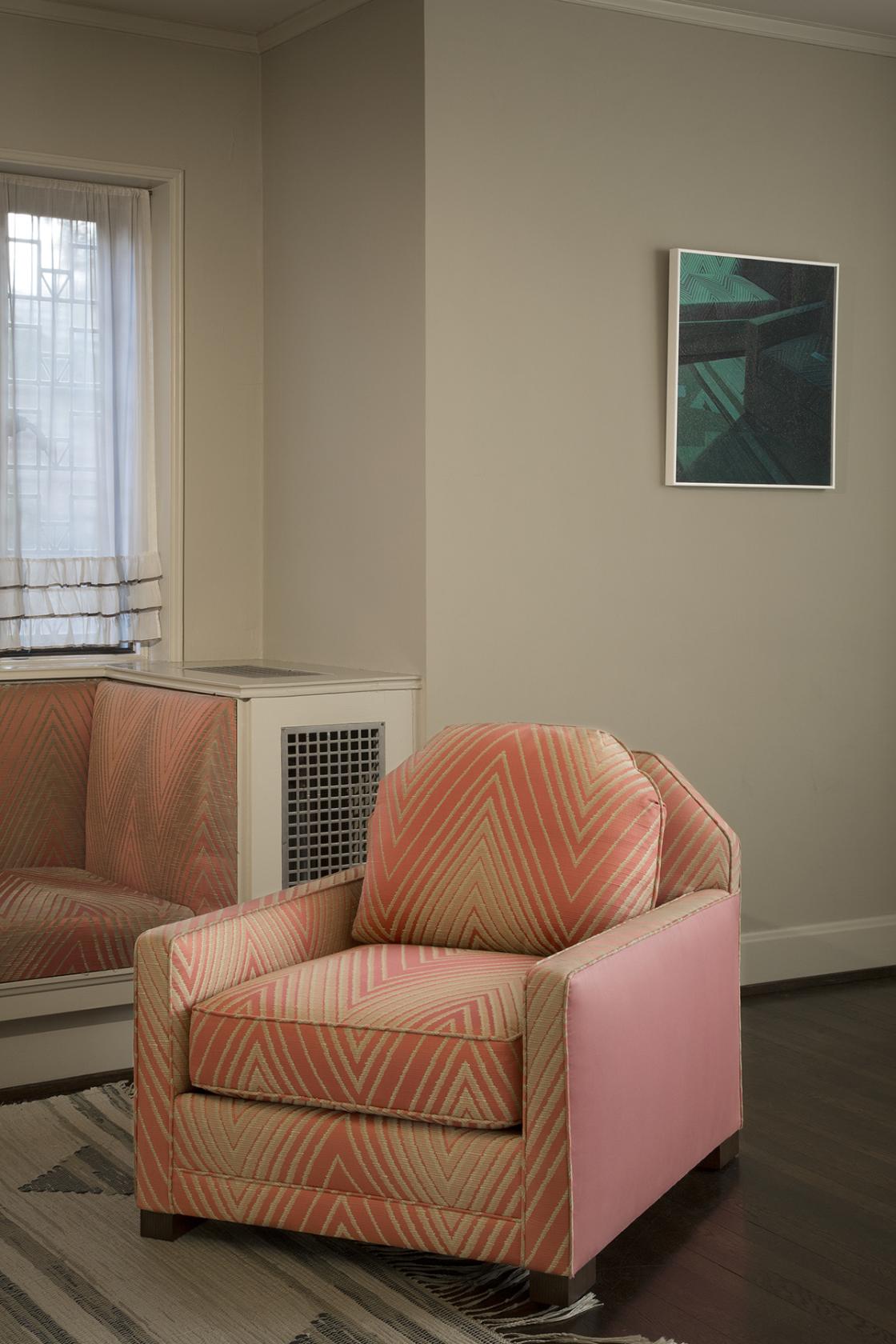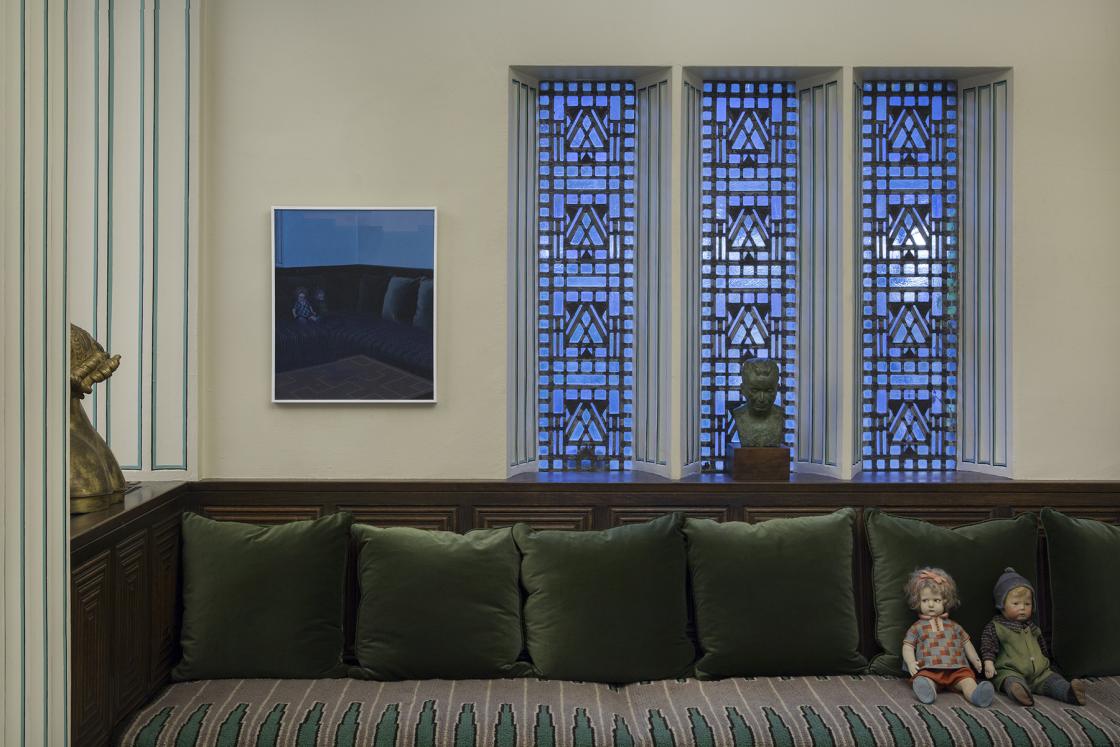EXHIBITION ESSAY
In this collection of eight site-specific paintings, Jason E. Carter imagines the carefully composed interiors of Saarinen House illuminated not by the architect’s studied placement of windows and lamps but by the cool light of anonymous screens. Darkened rooms are meticulously rendered in the diffuse blue glow of modern digital devices of an imagined resident.
The intimate scenes depicted require the visitor to consider the house in a way it was never used by its first residents: Eliel Saarinen died in 1950, well before televisions, laptops, and smart phones became omnipresent in our homes. By projecting the light of twenty-first-century technology through the interiors of this modernist masterwork-turned-museum, Carter makes the rarefied house strangely more familiar to our own lives.
Creating these works involved a laborious, time-intensive process at odds with the digital world they depict. Carter began by photographing Saarinen House at night, using a laptop as his sole light source. These photographs became reference photos that were then digitally manipulated into compositions for the canvas.
The new paintings are precisely the same size as works Eliel and Loja Saarinen collected and displayed in their home, so Carter’s intervention involved replacing only art hung by the Saarinens without altering the proportions or design intent of each space. This left intact the careful interior arrangements of furniture, textiles, lighting, and art developed by the Saarinens. As Eliel once observed, “To paint a picture is art, to hang it is architecture.”1 Carter respected Saarinen’s conception of architecture as inseparable from interior design, while challenging visitors to consider the house anew.

After Carter built support panels and stretched and sized canvases in his studio, he began painting each work with a simplified palette of oil paints reflecting contemporary digital color systems. Each work is built up using strictly a CMYW (cyan, magenta, yellow, white) palette, an adaptation of the CMYK (K being black) found in a typical digital printer. In confining himself to these four colors, Carter achieves the vibrancy and tone found in digital light. He also produces a wide variety of dark shades from the same colors.
Reflecting on historic artists’ palettes inspired Carter’s thinking about his own. In particular, Carter was drawn to the relationship between the dark, earthy palettes of the painters of the Ash Can School and their depictions of working-class life in the early twentieth century. By simply looking to the digital printing process, Carter found what he believes to be a color palette reflective of the digital age.
The resulting compositions reflect the dichotomy that’s inherent in the use of digital screens: the ability to connect to a global community while at the same time be disconnected from the room you’re in or the person you’re with. The paintings have a sense of singularity and tunnel vision. Chairs are either alone in the paintings or are not facing each other for engagement. The beds in the master bedroom are separated. There is an eeriness and beauty to the lighting. In #esaar_house_studio, the electric light fixture becomes an object being lit and denied its purpose. Even the process of painting is at odds with the fast speed of imagery intake from screen culture when compared to the slow, meditative process of building up oil paints.

There are notable absences in the paintings: where are the devices emitting the blue light? Where are the residents? Nowhere is this missing presence more pronounced than in #esaar_house_masterbedroom, where the soft bed linens and pillow shams are wrinkled by some past occupant. With all other lights and lamps turned off, the interior seen in the digital light can be ominous. In #esaar_house_livingroom, the ceramic fireplace and bronze andirons reflect the faint blue light, and the emptiness of the room is heightened by the canvas’s darkness.
Within the photorealistic paintings there are moments where byproducts of digital signals (shifts, glitches, color changes) are brought into the composition. This can be most clearly seen in #esaar_house_studioalcove.2, where a glitch obscures the eyes of Eero’s dolls. Carter traces these digital interruptions to techniques of destabilization and reframing used by the American Precisionist painters of the interwar period. Artists like Charles Sheeler (1883-1965) depicted the new machine age (the same era in which Saarinen House was built) as an era of progress alongside dehumanization and pollution, abstracted and interpreted on canvas.

Beyond the Precisionists, Carter’s sources of inspiration are varied: from the French Baroque painter Georges de La Tour (1593-1652), whose use of a single candle as a light source spoke to the relationship of light and religion, to contemporary artist James Turrell (b. 1943), whose installation art is entirely about light and what the viewer sees beyond what the artist sees. Essentially, American Luminists like Albert Bierstadt (1830-1902) and John Frederick Kensett (1816-1872), whose light-filled, contemplative views of the American landscape reflected an ideology of their time, inspired Carter to search out where our own American ideology might be found. He found it, perhaps, in screens.
All of these influences connect back to Eliel Saarinen, a painter and architect who drew on and connected traditions of craft, design, and aesthetics with contemporary form. Saarinen House, suspended in time as a museum, holds onto the philosophies and ideas of its creators. By bringing in the contemporary light of screens through paintings that bridge traditional and contemporary techniques, Jason Carter asks the viewer to reflect on the contrasts and similarities between the past and present moment. Importantly, he also asks us to consider our own relationship to screen culture.
Kevin Adkisson
Curatorial Associate
May 2019
FOOTNOTES
1 Aileen Ryan, “Furnish Home According to Principles of Architecture,” The Milwaukee Journal, January 18, 1942, section 7, p. 9, in Gregory Wittkopp, Saarinen House and Garden: A Total Work of Art (New York: Harry N. Abrams, 1995), 32.
